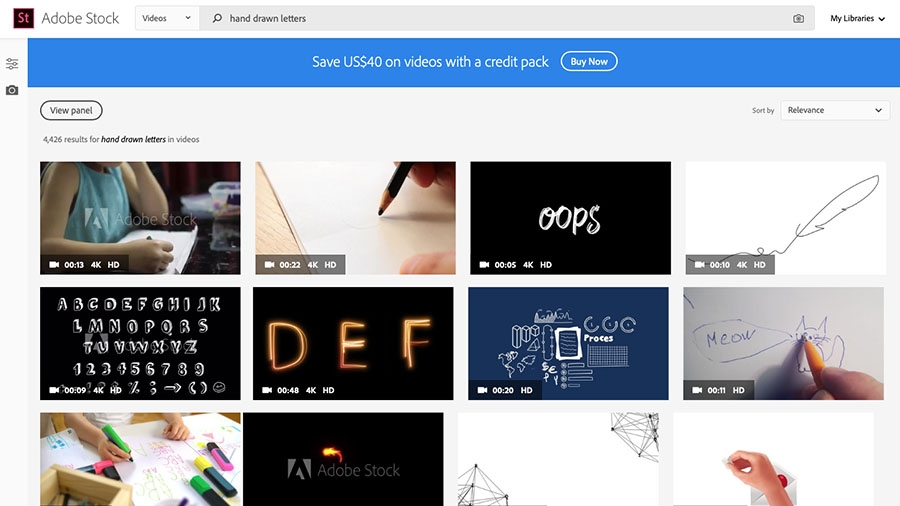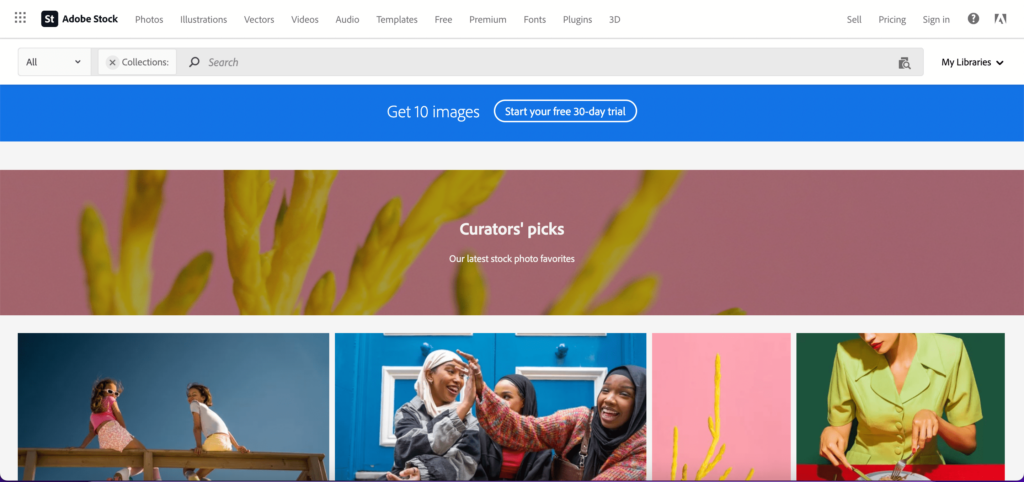Are you looking to elevate your projects with stunning visuals? Adobe Stock Images might be just what you need! This extensive library offers millions of high-quality images, videos, and templates that cater to various creative needs. Whether you’re a graphic designer, marketer, or content creator, Adobe Stock Images can help bring your vision to life. Let’s dive into what
Benefits of Using Adobe Stock Images

Using Adobe Stock Images comes with a plethora of advantages that can streamline your creative workflow and enrich your projects. Here are some key benefits:
- Vast Selection: With over 200 million assets, you’re bound to find the perfect image or video that resonates with your theme. From breathtaking landscapes to dynamic lifestyle shots, the diversity is astounding.
- High Quality: All images undergo rigorous quality checks, ensuring that you receive only the best. This means you can confidently use these visuals in any professional setting.
- Easy Integration: Adobe Stock seamlessly integrates with Creative Cloud apps like Photoshop and Illustrator. This allows for a smooth workflow where you can search for images without leaving your design software.
- Flexible Licensing: Adobe offers various licensing options, including standard and extended licenses. This flexibility caters to different project needs, whether for personal use, advertising, or large-scale distribution.
- Exclusive Content: Some images are exclusive to Adobe Stock, giving you access to unique visuals that set your work apart from the crowd.
Moreover, Adobe Stock regularly updates its collection, ensuring you have access to the latest trends and styles. So, whether you're crafting social media posts, website designs, or marketing materials, incorporating Adobe Stock Images can significantly enhance your aesthetic while saving you valuable time.
In summary, whether you're a seasoned creator or just starting, leveraging Adobe Stock Images can lead to visually compelling projects that capture attention and convey your message effectively. Ready to dive in? Your next great visual is just a search away!
Also Read This: How to Clip a Dailymotion Video with a Step-by-Step Guide for Video Editing
3. How to Search for Images on Adobe Stock

Finding the perfect image on Adobe Stock can feel a bit overwhelming at first, but once you get the hang of it, it’s a breeze! Here are some tips to help you navigate the search feature effectively:
- Use Specific Keywords: The more specific you are, the better your results will be. Instead of searching for “dog,” try “golden retriever playing fetch.” This narrows down your options significantly.
- Apply Filters: After your initial search, utilize the filters on the left side of the page. You can filter by image type, orientation, color, and even by the model’s release or property release. This helps refine your results to exactly what you need.
- Explore Categories: If you’re feeling a bit stuck, check out the categories provided. They can lead you to trending images or themed collections that might spark a new idea.
- Use Advanced Search: For those looking for something extra specific, Adobe Stock offers an advanced search option. Here, you can combine different keywords and apply various filters all at once.
- Save Your Searches: If you’re working on a long-term project, save your searches for easy access later. This is especially helpful if you often look for similar types of images.
With these strategies in hand, you’ll be able to sift through the vast library of Adobe Stock images quickly and efficiently. Remember, it’s all about finding that perfect visual that aligns with your project’s vision!
Also Read This: How to Upload Adobe Stock Images Using FTP
4. Understanding Licensing and Usage Rights

When using Adobe Stock images, it's crucial to understand the licensing and usage rights to avoid any legal hiccups. Here’s what you need to know:
Adobe Stock offers a couple of licensing options:
| License Type | Description |
|---|---|
| Standard License | This license covers most uses, like websites, presentations, and social media. However, there are limits on print runs and resale. |
| Extended License | This is for larger projects. If you need to use the images for merchandise or in a way that could generate profit, this is the way to go. |
Here are a few key points to consider about licensing:
- Attribution: Generally, you don’t need to credit the image creator, but it’s always a good practice to do so if you can.
- Restrictions: Avoid using images in a way that implies endorsement or in sensitive contexts, like portraying illegal activities.
- Non-Transferable: Licenses are usually non-transferable. So, if you buy an image, you can’t pass it on to someone else.
In summary, understanding and respecting licensing is crucial. Properly licensed images not only protect you from potential legal issues but also support the artists and creators behind those stunning visuals. So, always take a moment to review the licensing details before you hit that download button!
Also Read This: Number of Images Available in Adobe Stock
5. Best Practices for Downloading and Using Adobe Stock Images
When it comes to downloading and using Adobe Stock images, a few best practices can help you maximize your project's impact while avoiding common pitfalls. Here’s how to make the most of this fantastic resource:
1. Choose the Right Size: Before you hit that download button, consider the resolution you'll need. Adobe Stock offers various sizes; for print projects, opt for high-resolution images (300 dpi). For web use, high-definition (72 dpi) often suffices. Always choose the resolution that best fits your intended use to ensure clarity.
2. Utilize Collections: Adobe Stock allows you to create collections. As you browse, save your favorite images into themed collections. This makes it easier to find and compare options later, especially when you're knee-deep in project deadlines!
3. Check Licensing: Always pay attention to the license associated with each image. Adobe Stock typically offers two types of licenses: standard and extended. If you're using an image for a large print run or in merchandise, the extended license might be necessary.
4. Avoid Overused Images: Some stock images are popular and widely used, so they may lack originality. Try to find unique images that resonate with your brand's voice and message. This will help your project stand out from the crowd.
5. Keep Track of Your Downloads: Maintain a log of the images you've downloaded, including their licenses and any modifications made. This is especially useful for larger projects where multiple assets are involved. It ensures you comply with license agreements and can help you track your sources.
By following these best practices, you’ll not only streamline your workflow but also enhance the overall quality of your projects. Remember, thoughtful selection and usage can elevate your final output significantly!
Also Read This: How to Delete Your Adobe Stock Account
6. Editing Adobe Stock Images to Fit Your Needs
Once you've downloaded your chosen Adobe Stock images, the real fun begins—editing! Customizing stock images allows you to tailor them to fit your specific needs, ensuring they align perfectly with your project’s theme and vision. Here’s how to effectively edit these images:
1. Cropping and Resizing: Sometimes, the image you love isn’t quite right in its original form. Use cropping tools to focus on the most relevant part of the image. Changing the dimensions to fit your layout can also enhance visual appeal. For instance, if you’re designing a website banner, resizing to a 16:9 ratio might be key.
2. Adjusting Colors: Don’t hesitate to tweak the color settings! Adobe Lightroom or Photoshop provides robust tools to enhance saturation, contrast, and brightness. For instance, if an image feels too dark for your project, increasing brightness or altering the color balance can make it pop.
3. Adding Filters and Effects: Filters can give your images a unique flair. Whether it's a vintage look or a modern vibe, applying filters can set the tone for your project. Just be careful not to overdo it; subtlety often works best!
4. Integrating Text or Graphics: Sometimes, adding your branding or text directly onto the stock image can create a more cohesive look. Tools like Adobe Illustrator allow you to place text creatively, ensuring it complements the image rather than detracts from it.
5. Experimenting with Compositions: Don’t be afraid to think outside the box! Combine multiple stock images to create a new composition. Layer images creatively in Photoshop, playing with opacity and blending modes to achieve a unique look.
Editing Adobe Stock images can transform a simple stock photo into a powerful visual tool that resonates with your audience. Embrace your creativity, and don’t shy away from experimenting until you find the perfect fit for your project!
Also Read This: Explore What Percentage Shutterstock Takes from Contributors
7. Incorporating Adobe Stock Images into Your Marketing Strategy
When it comes to crafting a standout marketing strategy, visuals play a crucial role in grabbing attention and conveying your brand message effectively. Adobe Stock images can be a game-changer in this regard. Here’s how you can effectively incorporate these stunning visuals into your marketing efforts:
- Social Media Posts: Brighten your social media feeds with high-quality images that resonate with your audience. For example, if you're a fitness brand, using vibrant images of active individuals can inspire your followers and increase engagement.
- Email Campaigns: Enhance your email newsletters with relevant stock images. A visually appealing email can improve click-through rates significantly. Consider using images that reflect the content of your email, such as product photos or lifestyle shots that connect with your audience.
- Blog Illustrations: Break up text-heavy blog posts with relevant Adobe Stock images. This not only aids in visual storytelling but also keeps your readers engaged. For instance, if you're writing a post about travel tips, a stunning landscape image can really set the tone.
- Advertisements: Use high-quality images for both digital and print ads. Choosing the right visuals can enhance your message and attract your target audience. For example, an eye-catching image of a product in use can drive sales effectively.
- Website Design: Improve your website's aesthetics with Adobe Stock images. Ensure the images are consistent with your brand’s identity. A professional-looking website with appealing visuals can build trust and credibility.
Remember, the key is to select images that not only look great but also align well with your brand message. You want your visuals to evoke the right emotions and encourage action. Don’t hesitate to experiment with different styles and compositions to see what resonates best with your audience!
8. Conclusion and Additional Resources
In summary, Adobe Stock images are an invaluable resource for enhancing your projects, whether they're marketing campaigns, blog posts, or product designs. By understanding how to search effectively, use images responsibly, and incorporate them strategically, you can significantly improve the quality of your visual content.
To further support your journey with Adobe Stock, here are some additional resources:
- Adobe Stock Tutorials: Check out Adobe's official tutorials for tips on how to make the most out of your stock images.
- Stock Image Best Practices: Look for blogs and articles highlighting best practices for using stock images, focusing on image selection and integration.
- Design Communities: Join online forums or communities dedicated to design and marketing. Engaging with others can provide insights and inspiration.
- Social Media Inspiration: Follow brands and influencers on platforms like Instagram or Pinterest to see how they creatively use stock images.
By leveraging these resources and the power of Adobe Stock, you can elevate your projects and create visually compelling content that stands out in today’s crowded marketplace. So go ahead, get creative, and let those stunning images tell your story!
 admin
admin








